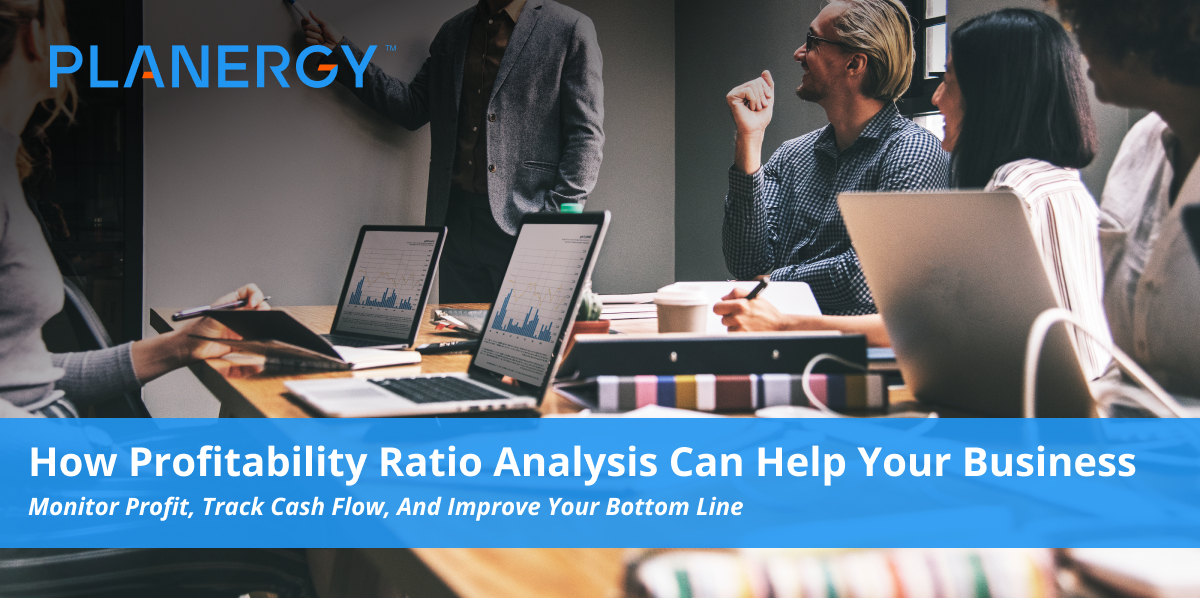Profitability Ratio Analysis
All business owners care about turning a profit. But profitability may be particularly important for small businesses with limited cash flow. And as important as profitability is to business owners, it’s equally important to creditors and investors.
One of the best financial management tools available is profitability ratio analysis. Profitability ratios are fairly easy to calculate, with most information obtained from a balance sheet or income statement.
For example, a company that has a net income of $5 million, and average assets worth $10 million can easily calculate a return on assets ratio.
$5,000,000/$10,000,000 x 100 = 50%
But what does that mean? Is 50% good or bad?
We’ll explain all of that later. But first, what is a profitability ratio?
What is a Profitability Ratio?
Profitability ratios are calculations you can perform that provide a measure of profitability while revealing insights into the health of your business.
Calculated over multiple time periods, these ratios provide financial insights useful for managing your business, can help you set benchmarks, and can provide detailed information to potential investors and financial institutions.
In this article, we’ll explore the most common profitability ratios, share their formulas, and explain how to analyze the results.
What is the purpose of profitability ratio analysis?
Profitability ratios are financial metrics used by business owners, accountants, investors, and creditors to evaluate the financial health of a business.
Profitability ratios can provide information such as how well a business generates income, if operating expenses need to be reduced, and how efficient a business is in generating income from existing assets and/or investors.
These financial ratios also provide interested parties with a way to track financial trends over an extended period.
In most cases, a higher ratio is a reliable indicator that a business is performing well. But keep in mind that profitability ratios should always be used consistently to better identify trends and make any changes if needed.
Companies typically use two categories of profitability ratios or financial ratios for analysis: profit margin ratios such as gross profit and net profit margin, and return ratios such as return on equity.
These two categories of ratios provide a more complete picture of the business. Calculating these ratios can also help answer the following questions:
- Is your business performance trending upwards or downwards?
- Can your business generate enough income to pay expenses?
- What are the weak parts of the business?
- How does your business compare to other similar businesses?
- Is your business currently a good investment?
Profitability ratio analysis can benefit just about any business by monitoring profit, tracking cash flow, and improving your bottom line.
What are the 5 main profitability ratios?
There are dozens of profitability ratios that business owners can calculate, but most businesses calculate a variation of the following:
- Gross Profit Margin
- Operating Profit Margin
- Net Profit Margin
- Return on Assets
- Return on Equity
Gross Profit Margin
Gross profit margin results indicate how efficient your overall business operation is.
One of the easiest profitability ratios to calculate, gross profit margin, also known as gross margin, calculates the amount of revenue your business has left over after subtracting your cost of goods sold.
Gross profit margin is calculated by subtracting your total cost of goods sold from your total sales revenue, which you can obtain from your financial statements.
Gross Margin = (Total Revenue – Cost of Goods Sold)/Total Revenue x 100
For example, AAA Automotive Parts has total net sales revenue of $800,000 for 2021 with their cost of goods sold totaling $560,000.
To calculate gross margin in dollars, use the following formula:
$800,000 – $660,000 – $140,000
However, most businesses like to calculate their gross margin as a percentage using the following formula:
($800,000 – $660,000)/$800,000 x 100 = 17.5%
This means that for every dollar of revenue generated, $17.50 is retained as profit.
Operating Profit Margin
Gross profit margin is an important metric for retail or manufacturing businesses that sell products. But to get a better look at overall profitability, business owners will want to calculate their operating profit margin.
The operating profit margin measures company profitability at the operating level deducting both cost of goods sold (if any) as well as operating expenses.
To calculate your operating profit margin, you’ll first need to calculate your gross profit, using the gross profit calculation.
You’ll then use your gross profit in the following calculation:
Gross profit – Operating expenses = Operating profit margin
For those that prefer a percentage, you can calculate your operating profit margin using the following formula:
Gross profit/Revenue x 100 = Operating Profit Margin
In our example using AAA Automotive Parts, we know that their gross profit was $140,000.
They also had operating expenses totalling were $85,000. To obtain operating income, subtract operating expenses from gross profit, which totals $55,000.
Next, we’ll calculate their operating profit margin below:
$55,000 / $800,000 x 100 = 6.88%
This result means that for every $1 earned, after the cost of goods sold and operating expenses are subtracted, AAA Automotive Parts retained $6.88 in profit.
Like your gross margin, you’ll want to regularly run your operating profit margin to compare to prior periods. You’ll also want to compare your results to your competitor’s results and make any changes or adjustments accordingly.
Net Profit Margin
Net profit margin is one of the most accurate indicators of financial health. Net profit margin, also known as net margin, calculates company profitability after the cost of goods sold, operating expenses, and interest and tax expenses have been deducted.
While gross margin focuses on manufacturing costs and operating margin focuses on both COGS and operating costs, net profit margin subtracts all expenses from the gross profit, calculating how much of each dollar in revenue is retained as profit.
Using AAA Automotive Parts above, let’s say that they have $5,100 in interest and tax expenses for 2021.
$800,000 Revenue
$660,000 Cost of Goods Sold
$ 85,000 Operating Expenses
$ 5,100 Tax and Interest
This means that AAA Automotive Parts’s net income for 2021 is $49,900. Let’s quickly calculate the net profit margin for AAA Automotive Parts:
$49,900/$800,000 x 100 = 6.24%
This result indicates that for every dollar in revenue that AAA Automotive Parts collected in 2021, $6.24 was retained as profit.
Return on Assets
The return on assets or ROA ratio calculates the amount of profit a business generates on its assets.
The return on assets ratio should be calculated yearly using the following formula:
Net Profit/Total Average Assets = Return on Assets
Before you can calculate ROA, you’ll first have to calculate your average total assets for the year by using beginning and ending asset totals found on your balance sheet. AAA Automotive Parts assets at the beginning of the year totaled $590,000 and at year-end, total assets were $775,000.
($590,000 + $775,000)/2 = $682,500 Average Assets for 2021
Now you’re ready to calculate your return on assets:
$49,900/$682,500 x 100 = 7.31%
This means that for every dollar of assets held by AAA Automotive Parts, they earned $7.31.
Return on Equity
The return on equity or ROE ratio is used to measure how much profit a business can generate using its current equity.
This ratio helps investors see the company’s ability to generate income with its invested capital. Calculated much like the ROA formula above, return on equity uses shareholder equity rather than asset totals to complete the calculation.
Like the ROA ratio, you’ll also have to calculate the average shareholder’s equity in order to calculate ROE.
FOr this example, we’ll say that AAA Automotive Parts shareholders’ equity at the beginning of the year is $690,000, with an ending total of $700,000.
($600,000 + $700,000) /2 = $650,000
To calculate your return on equity, do the following calculation:
$49,900/$650,000 x 100 = 7.7%
This means that AAA Automotive Parts’s annual profit is about 7.7% of its shareholder equity.
Along with the margin and return ratios, you may also want to consider running a net cash flow ratio; particularly if cash flow is an issue for your business. To calculate the net cash flow margin, you simply subtract cash outflows from cash inflows.
For example, if you have cash inflows of $100,000 and cash outflows of $80,000 you can perform the following calculation:
$100,000 – $80,000 x 100 = 20%.
This result shows that your business has a cash surplus of 20%.
You can choose to run any or all of the above ratios for your business, or choose the ratios that provide the information you need.
For example, if you’re a manufacturing company or a retailer, you’ll want to calculate gross profit, since it provides you with a good view of manufacturing costs.
Other businesses may want to calculate operating profit margin, which provides overall profitability after operating expenses have been accounted for.
If someone is interested in investing in your company, they’ll likely take a look at the net profit margin, which provides details on overall profitability, and the return on equity, which shows potential investors how much money your business currently earns from investments or equity.
How do you analyze profitability ratios?
Profitability ratios can be tremendously useful for business owners, but only if they’re properly analyzed.
Here are a few things to consider when analyzing your profitability ratio results.
- Past performance – If you consistently calculate profitability ratios for your business, be sure to compare your current results to past results to determine a trend. If your ratios increase year after year, that usually indicates a solid financial performance with consistent revenues and controlled costs.
- Check competitor ratios – One of the best ways to measure performance is to check your ratio results against those of your competitors. Keep in mind that different industries have different profitability ratio averages. For example, the average net profit ratio in retail runs between 0.5% and 3.5%, while the net profit margin for a professional services business averages 30%. When comparing your profitability ratio results, be sure to compare them only to businesses within your industry.
- Use the results proactively – After calculating profitability ratios for your business, be sure to use the results to improve financial performance for your business. For example, if your gross margin is good, but net profit is suffering, take a look at your overhead and associated operating costs. On the other hand, if your operating costs are minimal, but your cost of goods sold is high, look at inventory turnover rates or explore ways to bring those manufacturing costs down, such as automating production or finding another supplier.
What is the difference between profit and profitability?
Though both provide insight into the well-being of your business, profit and profitability are not the same things.
Profit is a number that is calculated at the end of every accounting period and is designed to measure how much money your business has left over after all expenses have been paid.
Profitability is a more long-term measurement, providing information not only on current profit but also looking at whether your business will likely be earning a profit in the future.
To measure profitability, it’s important to look at the complete financial health of your business including solvency and valuation, which along with profitability ratios, can provide a more complete measure of your company’s profitability. Solvency ratio analysis, activity ratio analysis, and valuation ratio analysis can all be useful tools.
How can you improve your profitability ratios?
What do you do if your profitability ratio results are less than satisfactory? Here are a few ideas:
- Lower your costs – Finding a new supplier, moving to a less expensive building, and consolidating operations can help reduce costs.
- Increase prices – After careful analysis, you may want to consider increasing prices, particularly if you’re regularly losing money on sales.
- Get rid of unprofitable products – If you’re losing money on one particular product, you may just want to stop selling it altogether.
Can profitability ratio analysis help your small business?
Profitability ratio analysis can benefit just about any business by monitoring profit, tracking cash flow, and improving your bottom line.
When used properly, both profitability ratios and financial ratio analysis can provide you with all the company performance details you need to run your business profitably.




